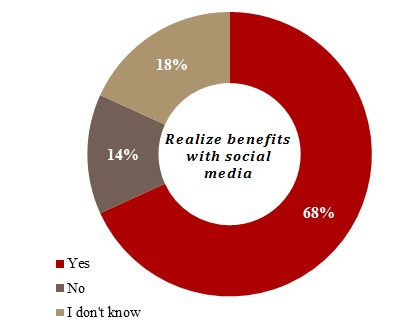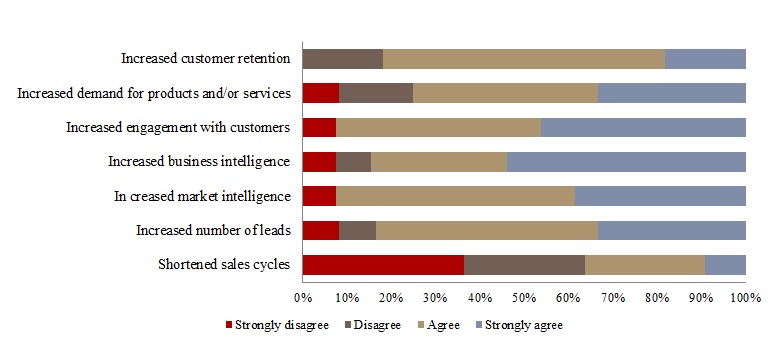
by Jennifer Hart Yim | Nov 4, 2014 | Blog, Leadership, Marketing, Social Media, Strategy
Within five years social media literacy will be the single greatest factor distinguishing top performing procurement leaders from the rest.
Now don’t get me wrong – that’s not to diminish the importance of superior financial skills, sourcing, and/or change or people management abilities, but simply to say that social media will add a new dimension to these existing critical competencies.
For Roland Deiser and Sylvain Newton, authors of McKinsey Quarterly ‘The six social media skills every leader needs’, social media has created a dilemma for executives: “while the potential of social media is immense, the inherent risks create uncertainty and unease.”
For those schooled in 20th century management theories, social media’s unscripted approach to conversations, horizontal collaboration and fragmented power structures, is undoubtedly unsettling.
But the transformative power of social media is too big, too loud, and simply too pervasive to miss.
Today, Procurement Leaders are expected to ‘do everything.’ Is social media just ANOTHER thing to add to their To-Do list?
Yes and no – but that doesn’t mean it has to be a thorn in your side. Instead, why not utilize the seemingly transformational power that social media represents? Not only will it allow you to manage change more effectively and maintain costs, but it will also negate the risk of unruly online behavior.
If you’re hoping social media is really just an issue for the Chief Marketing Officer (or perhaps even just your teenage daughter and son), this next statement is going to hurt: Every leader – regardless of industry or profession – needs to be social media savvy, and the expectations for CPOs to be masterful (not just literate) are ever greater. Here’s why:
1. Procurement needs to create 360 degree visibility
Social media visibility will help position yourself as a connected thought-leader in the eyes of not just your team, but your Board and suppliers too.
You’re in a unique position – as the facilitator of connectivity you should rightly take the lead when it comes to all-things social. Suppliers can benefit from simple initiatives like creating private groups that can be used as discussion areas.
2. Procurement needs to be a Customer of Choice (and stay ahead of sales during negotiations)
Your marketing team has probably been using social media to connect with customers for years. Although the use of social media to connect with suppliers is still in its infancy (although eMarket places are rapidly growing), be assured that sales executives are already scanning social media to understand your industry (and you as a customer) better.
3. Procurement needs to mitigate the risk
So here comes the scary part – while the benefits of social media are real, so too are the risks when it comes to issues of commercial in confidence and defamation.
Procurement (and your suppliers) deal with highly sensitive issues on a daily basis. CPOS must understand social media in order to develop and manage an operational social media policy that stimulates collaboration, but adequately mitigates risk. And don’t even think about a social media blackout…your employees, your suppliers, your customers are online so it pays to stay one step ahead.
4. Procurement needs to upskill… or die
There has never been a more pressing time to engage, retain and upskill existing procurement talent.
The labor market is tightening, bringing with it new risks.
Luckily social media breeds collaboration, making approaches such as peer-to-peer learning a viable (and cost-effective) option to procurement professionals looking to develop.
What’s more, by its very nature online learning is highly accessible and available across a range of devices and form-factors. At the time of writing, all of Procurious’ training modules are free to members. So go and get them while they’re hot!
If the thought of social media literacy has you thinking fondly of the ‘good old days’ of cost-downs and low hanging fruit, there is good news: like any skill, social media can be taught so start by mastering the basics, start with understanding:
- The different social media platforms – start with: Procurious; LinkedIn; Facebook; YouTube; Twitter; and Instagram. Think about their intended purpose, how they differ; their reach and their impact
- Basic Twitter functionality
- Simple social media terminology – start with: hashtag; retweet; like; follow; mention; blog; podcast; RSS feed. I recommend checking out Buzz Billboard’s Social Media Glossary here: https://www.buzzbinpadillacrt.com/social-media-glossary/
Now if all this sounds time consuming, well it can be…but it doesn’t have to.
Much like exercise, learning to juggle or learning the guitar, the key is usually to start small and be consistent. At Procurious, we recommend ‘The Daily Habit’ – it takes 15 minutes and can be done as you sip your morning double-shot skim latte:
Scan the Headlines – 5 min
Check the latest news and blogs, keeping your eyes peeled for “water cooler moments”, mentions of your suppliers or competitors in the headlines and be ready to dazzle colleagues and stakeholders with the factoids and market intelligence you’ve found.
Share – 4 min
What did you find that was interesting? An article? A comment? A quote? Well, post it to social media and get people reading and talking.
As procurement people we in fact have access to great, shareable content – in fact many of the best stories come out of buyer/supplier relationships: weird categories sourced; inspiring social procurement stories; and photos from Supplier Awards days.
Ask (or be) an expert – 4 min
One of the busiest parts Procurious is our Discussions area. Most social media platforms will have similar groups or boards where you can throw out a question to the network…..you’ll be impressed by the willingness of people to share their learnings….or at the very least, realize you’re not alone in your challenges!
Grow your network – 2 min
To be the world’s best at procurement, you need to be the most connected. Be referred. Invite people to join your social media networks – on Procurious, you can narrow this down by geography, industry and category which means you can connect with like-minded peers from across the globe. Aim to connect with 10 new people a day across your networks.
Change management, financial literacy, sourcing, vendor and people management will always be core to procurement. Social media, however, allows you to approach these tasks with far greater reach, influence and a superior market intelligence.
Lisa Malone is the General Manager – Procurious – the world’s first online business network for procurement and supply chain professionals.
If you’d like to learn more about how to grow your social media literacy, connect with her on Procurious at (it’s free to join and participate) or follow on Twitter @lisajoymalone.

by Fronetics | Oct 21, 2014 | Blog, Data/Analytics, Marketing, Social Media

Individuals within the logistics and supply chain industries want to learn more about social media ROI. A recent survey conducted by Fronetics found that 81 percent of respondents reported that information on proving social media ROI would be helpful to their company.
Proving social media ROI can seem impossible, but it is not if you put the right framework in place. Here’s how to put that framework in place, and prove social media ROI:
Set goals
Support your goals with SMART objectives. This allows you to track and measure your progress towards meeting your goals.
- Specific: Describe your objectives specific to the results you want. Go deeper than “gain leads” to “achieve a visitor to lead conversion rate of one percent.”
- Measurable: Metrics are essential. You can’t assess your progress towards your goal without metrics.
- Achievable: Make your goal achievable. A visit to lead conversion rate of 10 percent may not be realistic. Your goal of a visitor to lead conversion rate may be more plausible. When setting your objectives, keep reality in check.
- Realistic: As with any job, you need to have the right tools. Make sure that you have the resources, tools, and talent to meet your objectives.
- Timed: Be specific with your objective and incorporate a time frame.
Track and measure
Once you have set your goals and objectives and have identified your key metrics, put a system in place that will track and measure your metrics. At the very least, your metrics should be tracked on a monthly basis.
React
Tracking metrics is not enough. You need to react. Look at your metrics in the context of your goals and objectives. Which efforts are moving you towards your objectives and goals? Which efforts are not supporting your goals and objectives? Can these efforts be tweaked? Should you scrap them and try something new?
Taking a data driven approach is critical to proving ROI.
Wash. Rinse. Repeat.
This process is not static. When you achieve your goals and objectives, set new ones. If you are really struggling to meet your goals and objectives, you may need to revisit them to determine if they need to re-worked.
Proving social media ROI is possible. But it needs to be supported by a framework. Take the time to put a solid framework in place for your business.

by Fronetics | Oct 21, 2014 | Blog, Data/Analytics, Marketing, Social Media

Individuals within the logistics and supply chain industries want to learn more about social media ROI. A recent survey conducted by Fronetics found that 81 percent of respondents reported that information on proving social media ROI would be helpful to their company.
Proving social media ROI can seem impossible, but it is not if you put the right framework in place. Here’s how to put that framework in place, and prove social media ROI:
Set goals
Support your goals with SMART objectives. This allows you to track and measure your progress towards meeting your goals.
- Specific: Describe your objectives specific to the results you want. Go deeper than “gain leads” to “achieve a visitor to lead conversion rate of one percent.”
- Measurable: Metrics are essential. You can’t assess your progress towards your goal without metrics.
- Achievable: Make your goal achievable. A visit to lead conversion rate of 10 percent may not be realistic. Your goal of a visitor to lead conversion rate may be more plausible. When setting your objectives, keep reality in check.
- Realistic: As with any job, you need to have the right tools. Make sure that you have the resources, tools, and talent to meet your objectives.
- Timed: Be specific with your objective and incorporate a time frame.
Track and measure
Once you have set your goals and objectives and have identified your key metrics, put a system in place that will track and measure your metrics. At the very least, your metrics should be tracked on a monthly basis.
React
Tracking metrics is not enough. You need to react. Look at your metrics in the context of your goals and objectives. Which efforts are moving you towards your objectives and goals? Which efforts are not supporting your goals and objectives? Can these efforts be tweaked? Should you scrap them and try something new?
Taking a data driven approach is critical to proving ROI.
Wash. Rinse. Repeat.
This process is not static. When you achieve your goals and objectives, set new ones. If you are really struggling to meet your goals and objectives, you may need to revisit them to determine if they need to re-worked.
Proving social media ROI is possible. But it needs to be supported by a framework. Take the time to put a solid framework in place for your business.

by Fronetics | Oct 16, 2014 | Blog, Marketing, Social Media, Strategy, Supply Chain
A survey conducted by Fronetics Strategic Advisors found that companies within the logistics and supply chain industries are realizing benefits from social media.
When asked if their company realized benefits from social media 68 percent of respondents reported “yes.”

What benefits are companies realizing?
Increased engagement with customers (86 percent), increased market intelligence (80 percent), and increased business intelligence (73 percent) are the primary benefits reported by respondents. Other benefits include:
- Increased customer retention;
- Increased demand for products and services;
- Increased leads;
- Shortened sales cycles.

To learn more about the use, motivations, benefits, and challenges of social media and the logistics and supply chain industries, download our report: Social media and the logistics and supply chain industries.


by Fronetics | Oct 16, 2014 | Blog, Marketing, Social Media, Strategy, Supply Chain
A survey conducted by Fronetics Strategic Advisors found that companies within the logistics and supply chain industries are realizing benefits from social media.
When asked if their company realized benefits from social media 68 percent of respondents reported “yes.”

What benefits are companies realizing?
Increased engagement with customers (86 percent), increased market intelligence (80 percent), and increased business intelligence (73 percent) are the primary benefits reported by respondents. Other benefits include:
- Increased customer retention;
- Increased demand for products and services;
- Increased leads;
- Shortened sales cycles.

To learn more about the use, motivations, benefits, and challenges of social media and the logistics and supply chain industries, download our report: Social media and the logistics and supply chain industries.






